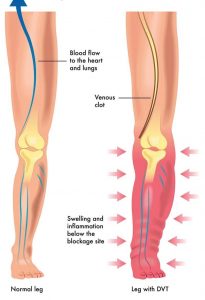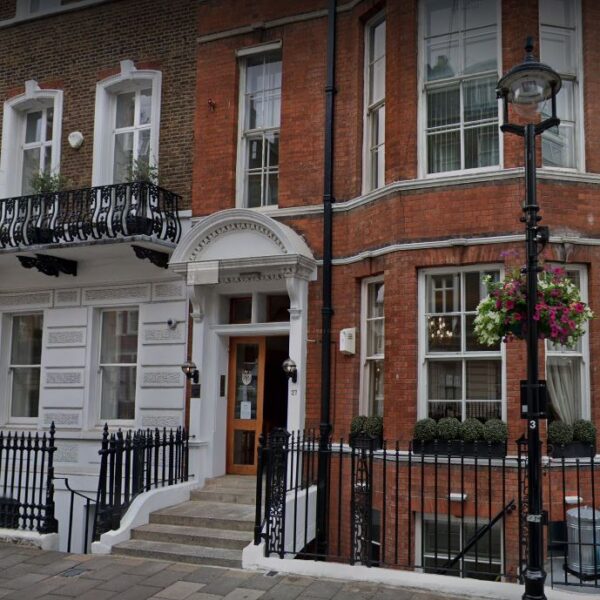
DVT Doppler Scan – One Limb
£215.00
A DVT Doppler Scan is a non-invasive ultrasound test used to check for blood clots (Deep Vein Thrombosis) in the veins—usually in the legs. It uses sound waves to measure blood flow and detect any blockages or clots, which can be serious if left untreated.
What Does It Evaluate?
- Presence of blood clots in the deep veins
- Blood flow in the leg veins
- Signs of vein compression or obstruction
- Risk of clot traveling to the lungs (pulmonary embolism)
Why Might You Need a DVT Scan?
A DVT Doppler Scan is recommended if you:
- Have leg pain, swelling, or tenderness
- Have recently had surgery, injury, or long travel
- Are pregnant or postpartum
- Use hormonal birth control or HRT
- Have a family or personal history of DVT or clotting disorders
- Are at risk due to immobility or hospitalization
Common Symptoms or Causes
You may need this scan if you notice:
- Swelling in one leg (usually below the knee)
- Pain or tenderness in the calf or thigh
- Skin that feels warm to the touch
- Red or discolored skin
- Cramping that worsens when walking or standing
- Shortness of breath (may indicate a clot has traveled to the lungs—seek emergency care)
Benefits of a DVT Doppler Scan
- Early detection of dangerous blood clots
- Painless and safe—no radiation or injections
- Helps prevent serious complications like pulmonary embolism
- Provides quick and accurate results for diagnosis and treatment planning
- Essential for peace of mind after travel, surgery, or during pregnancy
Don’t ignore the signs—book your DVT Doppler Scan today.
Book Your Appointment
Our Latest Google Reviews
EXCELLENTTrustindex verifies that the original source of the review is Google. Fantastic and hugely efficient service. Hana, the Cardiologist, was absolutely great - very knowledgeable with a great bedside manner. Thank you. Please don’t publish my name.Posted onTrustindex verifies that the original source of the review is Google. Excellent servicePosted onTrustindex verifies that the original source of the review is Google. Excellent servicePosted onTrustindex verifies that the original source of the review is Google. Excellent, professional and explained what was happening. Would highly recommendPosted onTrustindex verifies that the original source of the review is Google. A good experience all round. Helpful and friendly staff.Posted onTrustindex verifies that the original source of the review is Google. Great experience being treated special. It is very obvious that they value their clients. The sonographer assigned to me is very accommodating and knowledgable. Great experience.Posted onTrustindex verifies that the original source of the review is Google. I had a very good experience at the ultrasound clinic yesterday. I found them through their website and was able to book an appointment in the evening for the very next day. I met very helpful and professional doctors, and I just want to say thank you very much. I highly recommend this clinic to anyone who needs help!Posted onTrustindex verifies that the original source of the review is Google. Extremely professional from start to finish. I was reassured and given options for other tests that I didn’t think of. Thank youPosted onTrustindex verifies that the original source of the review is Google. Very relaxing, understanding and so helpful. Dr Reza see me and he was so patient and understanding and explained so much to me. Definitely recommend
Leg Doppler Ultrasound (Duplex) – What It Is, What It Shows, Cost & Results
Leg Doppler ultrasound (also called a Doppler test on legs, venous/arterial Doppler, duplex ultrasound of the legs or simply a leg Doppler) is a non-invasive scan that checks blood flow in the arteries and veins of your legs. It helps diagnose problems such as deep vein thrombosis (DVT), varicose veins and venous insufficiency, and peripheral arterial disease (PAD).
Quick summary
- Purpose: Assess leg circulation; look for clots, reflux (leaky valves), narrowing/blocked arteries.
- Also called: Doppler test for legs, leg Doppler ultrasound, colour Doppler for legs, venous/arterial duplex.
- Time taken: 20–45 minutes for one leg; 30–60 minutes for both legs (venous and/or arterial).
- Preparation: No fasting; wear loose clothing. Bring your medication list and compression stockings (if you have them).
- Pain & safety: Painless, no radiation, usually no side effects.
- Results: Same day or within 24–48 hours (local workflow may vary).
What is a Doppler test on the legs?
It’s an ultrasound scan that uses sound waves and Doppler to show both the structure of your leg vessels and the direction/speed of blood flow. With colour Doppler and spectral Doppler, the sonographer can detect abnormal flow patterns caused by clots, narrowed arteries, or leaky vein valves.
Types of leg Doppler scans
| Test | What it checks | Typical symptoms/uses |
|---|---|---|
| Venous Doppler (Duplex) – Legs | Deep and superficial veins, valve function, blood clots, reflux | Leg swelling, pain, redness, DVT risk, varicose veins, non-healing ulcers |
| Arterial Doppler (Duplex) – Legs | Arteries from groin to ankle, plaques/narrowing, occlusions | Calf pain on walking (claudication), cold feet, colour change, non-healing wounds, PAD screening |
| Both (Arterial + Venous) / Bilateral | Comprehensive circulation review in both legs | Complex leg symptoms, pre-op vein mapping, recurrent ulcers |
What does a leg Doppler show?
- Deep vein thrombosis (DVT) and superficial thrombophlebitis
- Venous reflux (leaky valves) causing varicose veins and chronic venous insufficiency
- Arterial stenosis/occlusion (peripheral arterial disease), plaque burden, waveform changes
- Blood flow quality to feet and toes; reasons for leg swelling or skin change
- Pre-treatment mapping for compression stockings, sclerotherapy or vein procedures
How is a Doppler test on legs done?
- You’ll lie on a couch; clear gel is applied over the leg.
- A hand-held probe is moved along your leg. Gentle pressure may be applied (especially for the venous exam) to test vein compressibility.
- You may be asked to breathe, bear down, or perform a calf squeeze while flow is measured.
- For arterial Doppler, waveforms and pressures may be recorded at multiple levels (ankle-brachial index/toe pressures where needed).
Is it painful? No—some pressure can feel firm but it shouldn’t be painful. Tell us if you’re sore.
How long does a leg Doppler take?
Venous or arterial (one leg): 20–30 minutes. Bilateral venous or bilateral arterial: 30–45 minutes. Combined arterial + venous can take up to 45–60 minutes. Allow extra time for documentation.
How to prepare
- No fasting; take your usual medicines unless your clinician advises otherwise.
- Wear shorts or loose trousers that roll easily above the thigh.
- Bring previous reports and your compression stockings if you use them.
- If you have acute pain/swelling and DVT is suspected, attend promptly.
Results: what your report means
Your Doppler test results describe anatomy and blood-flow findings. Common terms:
- Normal – veins compressible, no thrombus; triphasic/biphasic arterial waveforms; normal velocities.
- Thrombosis – acute vs chronic DVT; extent and location (e.g., femoral, popliteal).
- Venous reflux – valve incompetence with reflux times (e.g., >0.5–1.0 s) and affected segments (GSV/SSV perforators).
- Arterial disease – % stenosis, peak systolic velocities, monophasic waveforms indicating downstream narrowing/occlusion.
Next steps may include compression therapy, anticoagulation (for DVT, as clinically indicated), endovenous treatment, lifestyle and medication for PAD, or referral to vascular surgery.
Common reasons to book a Doppler scan of the legs
- Leg swelling, redness or sudden pain (rule out DVT)
- Visible varicose veins, skin darkening, itching, ulcers
- Calf pain when walking, cold feet, pale/blue toes (peripheral arterial disease)
- Before venous procedures or for compression stocking fitting
- Follow-up after treatment to confirm success
Safety, risks & limitations
- No radiation, no injections required for standard exams.
- Not a substitute for CT/MR angiography when detailed arterial mapping is needed.
- If DVT is strongly suspected and ultrasound is negative, follow-up imaging or D-dimer may be advised.
Prices & availability
| Scan | What’s included | Guide price* |
|---|---|---|
| Venous Doppler (one leg) | Deep & superficial veins, reflux/DVT assessment, consultant report | £— |
| Venous Doppler (both legs) | As above, bilateral | £— |
| Arterial Doppler (both legs) | Arterial duplex with waveforms/indices, consultant report | £— |
| Arterial + Venous (both legs) | Comprehensive circulation study | £— |
*Prices vary by location and whether bilateral/both systems are scanned. Contact us for today’s fee schedule.
FAQs
What is a Doppler test?
An ultrasound that measures blood flow using the Doppler effect. In the legs it’s used to detect clots, valve reflux and arterial narrowing.
What does a leg Doppler test show?
It shows whether blood is flowing normally in your leg arteries and veins and identifies DVT, varicose reflux, or blocked/narrowed arteries.
How long does a Doppler test on legs take?
Usually 20–45 minutes (one system/one leg) and up to 60 minutes for both legs or combined arterial+venous studies.
Is a Doppler test painful?
No. It’s non-invasive and painless. You may feel firm pressure from the probe.
Do I need to fast?
No fasting is needed for a leg Doppler ultrasound.
What happens if the Doppler test is positive?
It depends on the finding. A confirmed DVT may require blood thinners; venous reflux may be treated with compression or vein procedures; PAD may need medication, exercise therapy, or vascular procedures.
How much does a Doppler test for legs cost?
Costs vary by clinic and whether one leg or both, venous and/or arterial are scanned. See our price table or contact us for a quote.
Private Ultrasound Clinic
All part of our services, from our specialists to our technology and, of course, our clinic, is designed to deliver the greatest possible experience for all of our patients and visitors.
We are conveniently located a stone throw famous Harley Street of London and our clinic is a place where you may feel safe and clean, comfortable, and reassuring environment.
Central London Branch: 27 Welbeck Street, London, W1G 8EN
St Albans Branch : 54-56 Victoria St, St Albans, AL1 3HZ
Tel: 020 7101 3377

